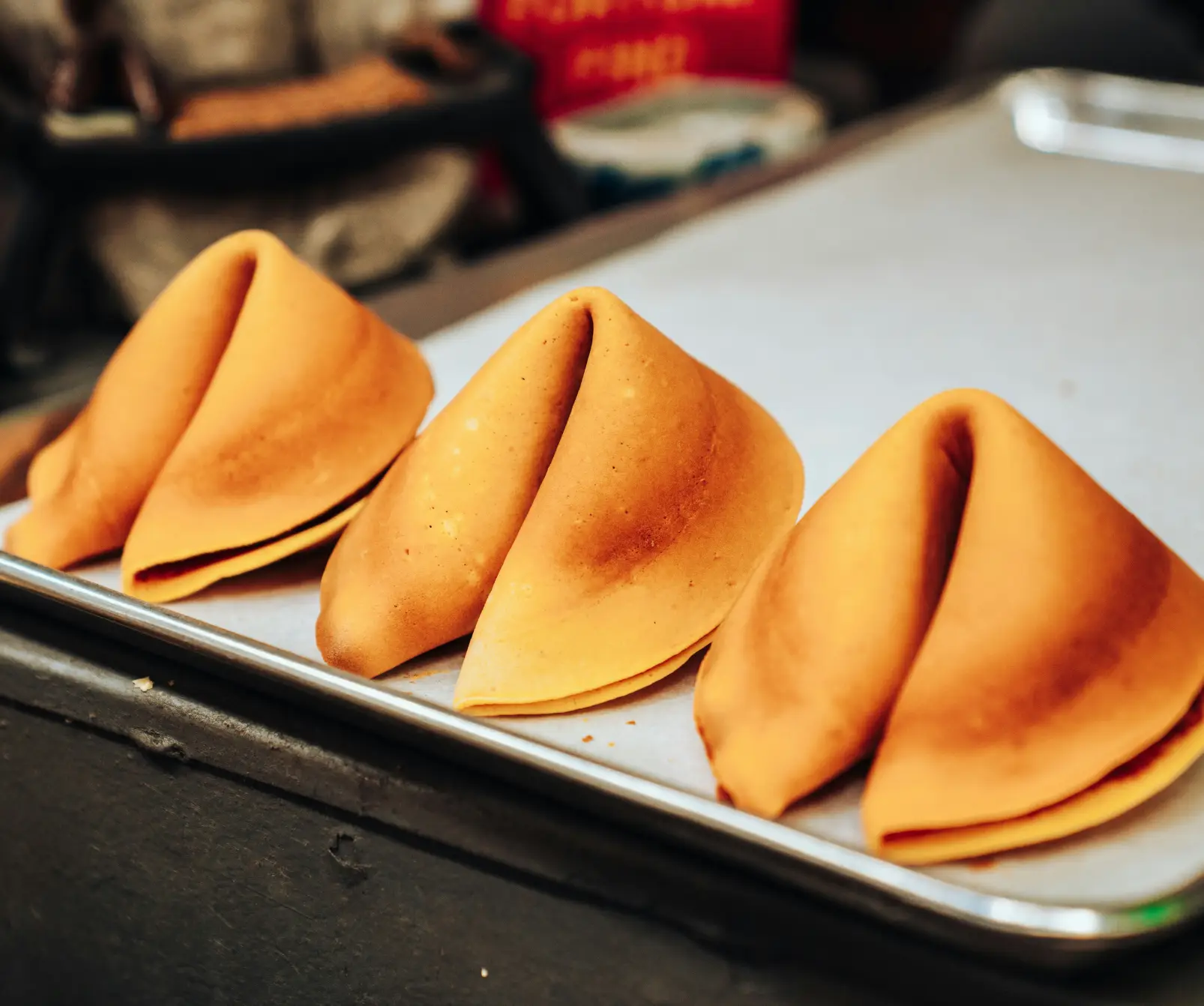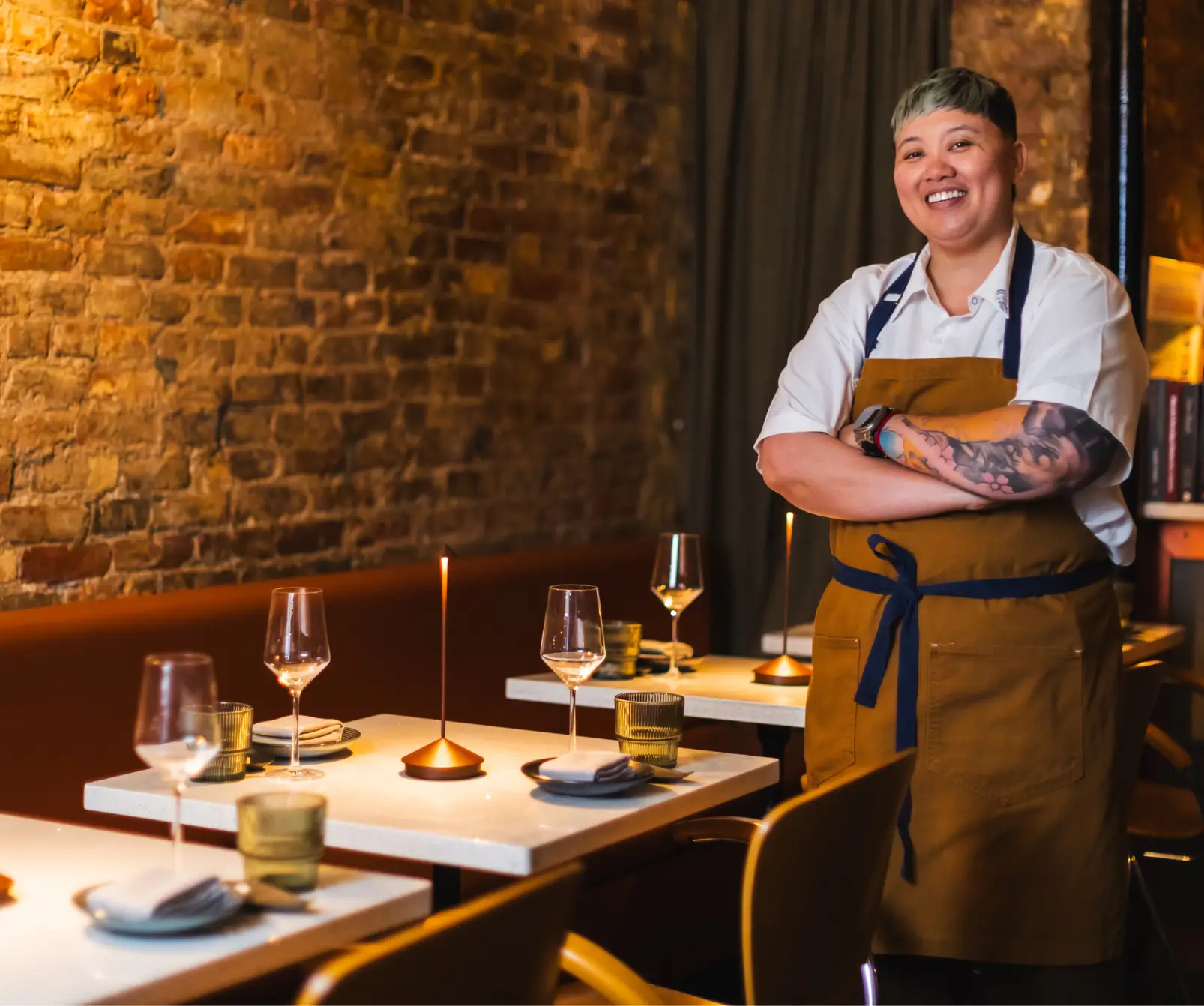What is it about the crispy crescent-shaped cookie, brought out at the end of a large meal on a little black tray carrying your check that brings a childlike excitement to the end of a meal? Some of us probably don’t even care so much for the actual cookie. We just want to crack it in half and pull out the little white strip of paper for our fortune and lottery numbers!
Sometimes we’re greeted with thoughtful words that promise good fortune. Sometimes we’re greeted with a warning. Sometimes we’re just greeted with strange and funny statements. No matter the words though, those little fortunes never fail to spark a moment of curiosity, laughter, or even a playful sense of wonder about what the universe might have in store for us next.
However, as with many food origin stories, there are competing claims to who was the OG fortune cookie creator. But one thing seems to be clear…the fortune cookie is not actually Chinese. Keep reading for the history of this crunchy treat and its winding tale of immigration, adaptation, and the complexity of cultural ownership and appropriation!
An SF vs LA Rivalry Story
In 1983, a mock (and culturally insensitive) trial took place at the Court of Historical Review in San Francisco (this court holds no legal or academic authority) to determine where the fortune cookie originated. Was it in San Francisco by Makoto Hagiwara who served the cookies at the Japanese Tea Garden in Golden Gate park as early as 1914? Or was it David Jung, a Chinese immigrant who founded the Hong Kong Noodle Company, who reportedly handed out fortune-filled cookies to the poor, inscribed with Bible verses to lift their spirits?
Let’s take a look at both stories…
Our first story takes us further back than San Francisco. In fact, it takes us all the way back to 19th Century Kyoto. The crispy, folded cookie as we know it today is believed to have roots in Japan, where it closely resembles the tsujiura senbei—a cracker-like cookie with a paper fortune inside. These Japanese goodies were made with sesame and miso, featuring a similar shape and folded design. They even had messages, but with more poetic (and less lottery-inspired) fortunes.
The tsujiura senbei was mainly street food, though you could also find them at temples and shrines. And it wasn’t until the late 19th century and early 20th century that they journeyed across the Pacific when Japanese immigrants brought their senbei-making traditions to the United States.
This brings us back to Makoto Hagiwara, who became the first Japanese immigrant to open a restaurant in San Francisco. Makoto handed out these cookies as a way of saying thank you to the people who supported him after he lost his job due to anti-Japanese sentiment.
Around the same time, in Los Angeles, David Jung was also staking a claim to originating the fortune cookie with his bible-inspired message in a cookie. According to legend, in the 1910s, Jung created the cookie not as a dessert, but as a way to uplift the spirits of the poor and homeless in his community. These “message in a cookie” confections were created to offer words of hope during a period of widespread hardship and poverty. Although some think that it was more a gimmick to help him sell more noodles.
Whichever story you believe, the mock trial in 1983 declared San Francisco the birthplace of the fortune cookie–which may be suspect given that the court is located in San Francisco. Moreover, the trial itself, with its use of yellowface and culturally insensitive portrayals, carried blatant racism, leaving plenty of room for skepticism…
A Cookie of Opportunity
What is clear, though, is how the fortune cookie found its way into Chinese American restaurants. During World War II, Japanese Americans were forcibly relocated to internment camps, leaving many Japanese-owned businesses—including bakeries—vacant. This opened the door for Chinese-owned companies to take over production of the fortune cookie.
And here’s the twist: many of these Chinese restaurateurs were quick to adopt the cookie as their own, tweaking the recipe to appeal to American tastes by adding a hint of vanilla and changing the fortunes from serious proverbs to more playful, fortune-telling messages. The fortune cookie then made its way across the U.S., solidifying its status as a Chinese American dining staple.
The Fortune Cookie Today
Fast forward to today, and the fortune cookie has become a beloved (albeit misunderstood) part of American pop culture. Around 3 billion of them are produced annually, mostly in the U.S. and Mexico—not China. The biggest fortune cookie manufacturer, Wonton Food Inc., is headquartered in Brooklyn, New York. And if you ever dine in China? Don’t expect a fortune cookie with your meal—it’s about as foreign there as chop suey!
So next time you crack open one of these delicate treats, take a moment to appreciate its wild history. From the tea houses of Kyoto to the noodle shops of Los Angeles, the fortune cookie is a story of cultural exchange, adaptability, and the sweet promise of good things to come.
What Does the Future Hold?
The fortunes inside have evolved over the years, too. Gone are the days of “You will meet a mysterious stranger.” Today’s fortunes can range from silly quips to wise career advice, and some even have QR codes for a high-tech twist! So, while the exact origins of the fortune cookie might be up for debate, one thing’s for sure: it’s a tasty testament to the American melting pot.
In the end, that’s the real fortune the cookie offers—a delicious reminder that sometimes the best things are born when cultures mix, stories merge, and new traditions unfold.
What’s the most surprising fortune you’ve ever cracked open?






